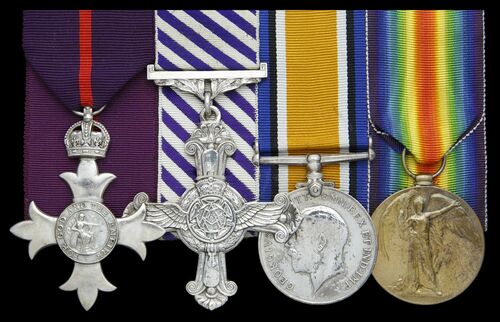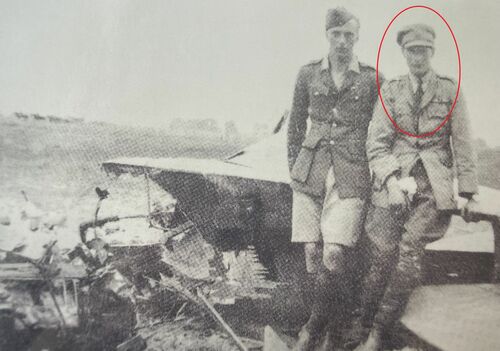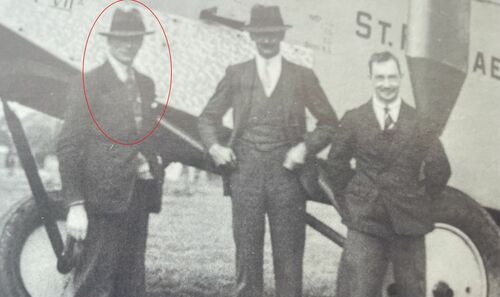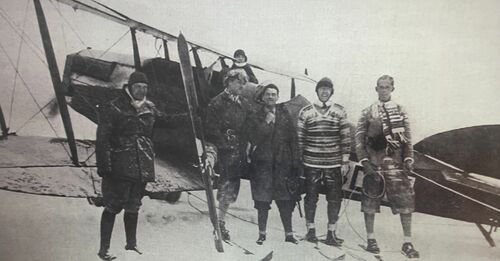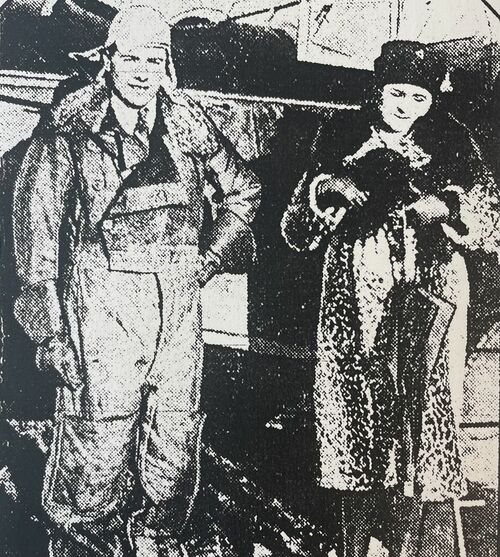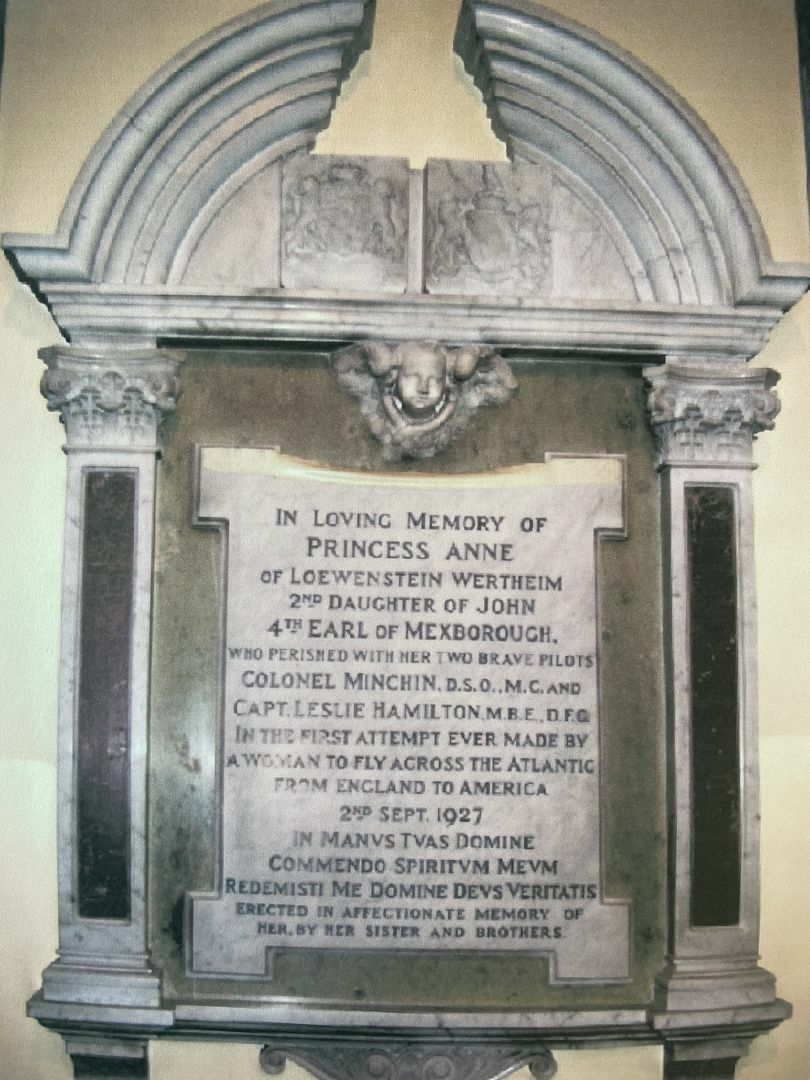Auction: 24001 - Orders, Decorations and Medals
Lot: 214
A very fine Great War Ace's D.F.C., post-War Test Pilot's M.B.E. group of four awarded to Captain L. Hamilton, Royal Air Force, an S.E.5a Pilot with No. 17 and 150 Squadron who notched up 6 'kills' over Salonika in short order
Latterly a Test Pilot with a reputation for stunt work, he was killed in an attempted Trans-Atlantic crossing in 1927, when accompanied by the Princess Löwenstein-Wertheim and Colonel Minchin; they had hoped to complete the first East-West Crossing - and take the $25,000 bounty put up - in the aftermath of Charles Lindbergh's West-East Crossing earlier that year
The Most Excellent Order of the British Empire, 1st Type, Military Division, Member's (M.B.E.) breast Badge, silver (hallmarks for London 1919); Distinguished Flying Cross, G.V.R.; British War and Victory Medals (Lieut. L. Hamilton. R.A.F.), good very fine (4)
Provenance:
Sotheby's, March 1982.
M.B.E. London Gazette 2 June 1923. The following citation from an official source:
'This officer has shown the greatest keenness and ability as a Pilot in carrying out a considerable amount of night-flying during the winter of 1922-23, in connection with lighting experiments conducted by the Controller of Communications.
The collection of data has been of great value to both service and civil aviation and has been made possible by his very marked devotion to duty and entire disregard of his own personal safety under extremely adverse weather conditions.'
D.F.C. London Gazette 8 February 1919:
'A gallant and skilful scout pilot who never hesitates to attack enemy formations, however superior in numbers. During recent operations he has rendered exceptional service. He has himself brought down, or assisted to bring down, six enemy machines.'
Leslie Hamilton was born in India in 1897 and during the Great War first served with the Inland Water Transport, Royal Engineers. He was a 2nd Lieutenant serving at Basrah, Iraq from 12 June 1916 and then transferred to the Royal Air Force in August 1917. Serving with No. 58 Training Squadron, he qualified as a Pilot in February 1918 and served in No. 17 Squadron until the Squadron was amalgamated with No. 47 Squadron to form No. 150 Squadron in Salonika in April 1918. The Squadron was formed to fight on the Salonika Front in Greece-Bulgaria where Britain aided Greece in fighting Bulgaria. Hamilton was clearly a Pilot of great skill and notched up 'Ace' status in short order, all in the S.E.5a in 1918:
21 April 1918, 1115hrs 17 Sqn. DFW C.V. Out of Control, Barakli-Dzuma:
'The DFW was observed by SE5a B.694 (HAMILTON) flying South over BARAKLI DZUMA. It was engaged by B.694 (Hamilton) who fired 50 rounds from forward gun. Subsequently the DFW was engaged by SE5a B.690 (Goulding), the enemy machine at the time was diving steeply for RUPEL PASS. SE5a B.694 (Hamilton) again dived on enemy machine, firing 150 rounds from close range. The hostile observer was seen to be out of action and the hostile machine was observed to be slipping from side to side. After B.690 had again dived on enemy machine B.694 (Hamilton) engaged it from underneath at 20 feet firing a drum of Lewis into the fuselage of enemy machine. The E.A. fell away in a vertical dive N. of KULA. The actual crash was not observed as B.694 rejoined B.690.'
4 May 1918, 1040hrs 150 Sqn. DFW C. CAPTURED, Marian Aerodrome. Crew killed:
'S.E. while on patrol at 13,000ft observed a DFW escorted by 2 DIII's or DV's. S.E.5 followed the other S.E.5 and engaged the two-seater at close range firing 100 rounds. EA was observed to go down completely out of control, gliding on its back and followed by both SE5's, eventually crashing near MARIAN Aerodrome, both occupants being killed. The enemy scouts did not attempt to take part in combat..'
15 June 1918, 0930hrs 150 Sqn. Albatros D.V. Out of Control, Dragotin:
'While escorting reconnaissance to MARINOPOLJE I dived on hostile machine (Siemens-Schukurt) attempting to attack AW. EA dived on AW but I followed it down, firing continuously, to 6,000 ft. when EA appeared to go out of control. S.E.5 then pulled up to rejoin others as three EA were in the vicinity.'
23 June 1918, 0745hrs 150 Sqn. Albatros D.V. Destroyed, Hill 5401, Rupel Pass:
'After escorting bombing raid to MARINOPLJE, S.E. formation returned to attack several EA's over RUPEL. Leader dived on one DV scout and I followed him firing 50 rounds from front gun. Leader broke off and EA flattened out at 9,000 ft. and manoeuvred for firing position. I succeeded in getting on EA's tail and fired 250 rounds from both guns at close range. EA dived and half spun and was seen to crash near hill 5401 by Capt. Bell and Lt. Boyd-Harvey.'
4 September 1918, 1055hrs 150 Sqn. C Type, Destroyed, North of Karusu Bridge:
'Whilst returning from Recon. I noticed EA 2,000 ft. below. I dived down and fired many bursts into EA which manoeuvred down to 1,000ft followed by Lt. Travers and myself both firing at favourable opportunities. After firing a good burst at 50ft. from ground, EA landed and turned upside down in a field. One man got out from underneath EA and ran into some bushes. Field is about 1/2 mile N. of KARASU BRIDGE next to the river.'
18 September 1918, 0700hrs150 Sqn. Fokker D.VII, Out of Control, Karali:
'While on patrol with Capt. Bell, Capt. Brawley and Lieut. Beeney we encountered 5 Fokker Biplanes in formation. During engagement which lasted an hour, I, on one occasion, succeeded in getting a good burst into one EA which apparently went down out of control, but was not observed to crash owing to close engagement with the other 4 EA's. At other periods during combat I fired altogether 150 rounds from Vickers Gun at different EA's.'
A number of other non-decisive Combat Reports are provided but his official tally reflects his outstanding ability. During the Great War, he struck up a friendship with Freddie West, who himself took a V.C. during the conflict. West coined Hamilton 'The Flying Gipsy' and latterly recalled:
'A rattling good Pilot he was...mad on music and a great charmer. The girls fell for him by the dozen. He was handsome, dark and debonair, very happily married, bubbling over with vivacity, always gay, and on top of all that he had this dare-devil flying reputation - enough to make any girl swoon. He played piano beautifully - mostly jazz in those days, but he could play anything. With all his attractions for the fair sex he was a man with no conceit in his make-up. The result was that he was very popular.'
After the Great War, Hamilton became a test Pilot but built his repute for pushing the boundaries as a stunt Pilot. Whilst crossing the Alps, he stopped off at St Moritz and proceeded to fly along the lake pulling skies behind him. Those fellows who skied behind included Prince Odescalchi, Lord Northesk and Jack Dowman. Charles Lindbergh had completed the first Atlantic crossing from West-to-East in May 1927, and pressure was building for an East-West crossing, attracting a $25,000 prize. Princess Löwenstein-Wertheim wanted to be the First woman to accomplish the Atlantic crossing flight. In August 1927, Freddie West found himself hosting a trans-Atlantic flying attempt from RAF Upavon, where he was Adjutant. He was delighted to discover that Hamilton would be part of the team, together with the aircraft's skipper Colonel F.F. Minchin, C.B.E., D.S.O., M.C., an Imperial Airways Pilot, and the aircraft owner, Princess Lowenstein-Wertheim, a glamorous and determined lady who was anxious to make the first East-West crossing, a distance of 2,700 miles to the intended landing place in Ottawa. Freddie West, however, quickly discovered that Hamilton only rated their chances at around 50 percent:
'This time...I'd rather be a rank outsider on any racecourse in England.'
Aware that backing out would have an appalling comeback in the media, Hamilton was adamant that the flight would go ahead. He was perfectly resigned to his fate, '...if I go out, it's the way I'd like to go out.' Recent publicity had announced a rival in the form of an American millionaire named Levine, and Minchin was as anxious as the Princess that everything must proceed soonest. When the news of yet another rival was reported, the Princess telephoned Upavon to tell Minchin and Hamilton for an early start the following day:
'She's worth fourteen gallons of petrol, nearly an hour in the air, if you count her wicker armchair and her hatboxes and her thermos flask and so on...I'm afraid it's goodbye to all this, goodbye to my family. Goodbye to old England and the RAF boys.'
Given the anxiety which Hamilton was going through, West was very impressed by his outward bearing, 'Cool as a cucumber', no less.
Their plane, a Fokker FVIIa, named 'St. Raphael', had been the centre of attention among West's men but the arrival of the Princess in her Rolls-Royce at dawn on 31 August 1927, sent the Officer's Mess into near chaos. Sporting 'off-mauve coloured riding breeches, a blouse under a leather jacket of the same colour, yellow tan, high heeled riding boots with heavy fur edging and a kind of Napoleonic-looking black straw hat on her head, with a brim that fell downwards over her ears', she appeared very relaxed. She did however, ask for some brandy in her coffee before departing for the hangar. Hamilton, meanwhile, thrust £25 at West to give to the mechanics who had so ably looked after the 'St. Raphael.' Besides, he observed:
'It's better they have it than the fishes...goodbye old man, and thanks for all you have done for us.'
It was to prove their final exchange. Princess Lowenstein-Wertheim was a remarkable lady, born Lady Anne Savile on the 25th May 1865 at Methley Hall, the ancestral home of the Earls of Mexborough in Yorkshire, she was the second daughter of John the 4th Earl who owned the Church and his wife Agnes who was the niece of Alexander Raphael, who built the Church. She married HSH Prince Ludwig Karl zum Lowenstein Wertheim and spent part of her honeymoon at Ditton Lodge, Thames Ditton. Her marriage made her a German citizen. The Princess was a widow after only a year and 10 months as Prince Ludwig died fighting for the Spaniards against the Americans in the Philippines in March 1899. In June 1914, the Princess aged 49, took flying lessons with Mr. Baumann of the Beatty Flying School in a dual-control Handley Page bi-plane. After the Great War she regained her British nationality.
They took off at 0733hrs from Upavon, Wiltshire on the 3,600 mile flight to Ottawa, The Princess sat in a wicker chair in the rear with 8 tanks of petrol, enough for 44 hours of flying, on a trip expected to take 37 hours. The take-off was dramatic. The Fokker, with an all up weight of 11,000 pounds, used every one of the 1,020 yards of Upavon's runway before Minchin was able to lift it just clear of a road bank and barbed wire fence.
They were last sighted by the oil tanker Josiah Macy at 2144hrs (airborne 14 hours) halfway across the Atlantic flying in a Westerly direction. The Prince of Wales, later King Edward VIII & The Duke of York, later King George VI, were both in Canada at the time and delayed their return to England to welcome the plane on its arrival in Newfoundland. Hundreds of people waited and watched all night, but the plane, the Princess and her two Pilots were never seen again. For years, searchers combed the Canadian wilderness for wreckage but nothing was ever found. Before disappearing, they had been averaging only 70 mph ground speed, far slower than the hoped-for 100mph. A few days after their disappearance, scraps of a broken plane were found off the coast of Iceland. Among them was a wheel and a wicker chair. There was no doubt this was all that remained of the St. Raphael despite the fact that the bodies of the crew and passenger were never recovered.
Given the location of portions of their wreck, perhaps the crew took the decision to try and make land at Greenland or Iceland. Instead of being the First Woman to cross the Atlantic by air, The Princess earned the dubious distinction of being the first woman to perish on a trans-Atlantic flight. Hamilton sadly joined an ill-fated cadre of Aviation Pioneers including Charles Nungesser, Charles Ulm, Amelia Earhart and Charles Kingsford-Smith. He is officially recorded as having died on 31 August 1927, aged just 30.
Subject to 20% VAT on Buyer’s Premium. For more information please view Terms and Conditions for Buyers.
Estimate
£6,000 to £8,000
Starting price
£5500

